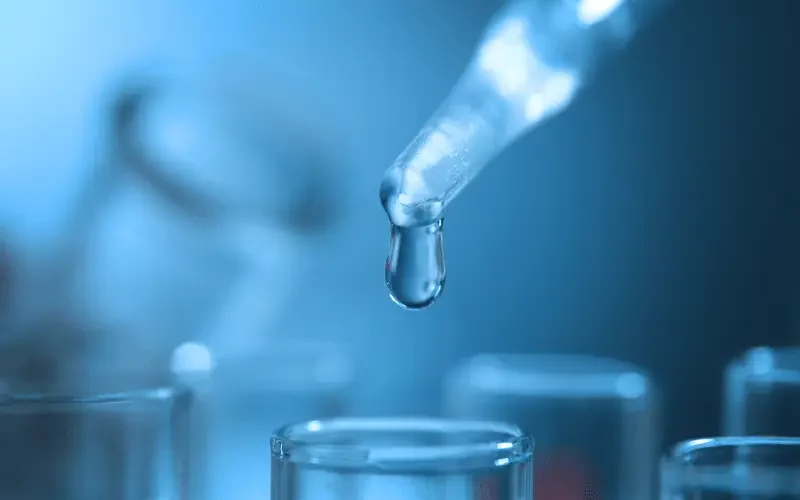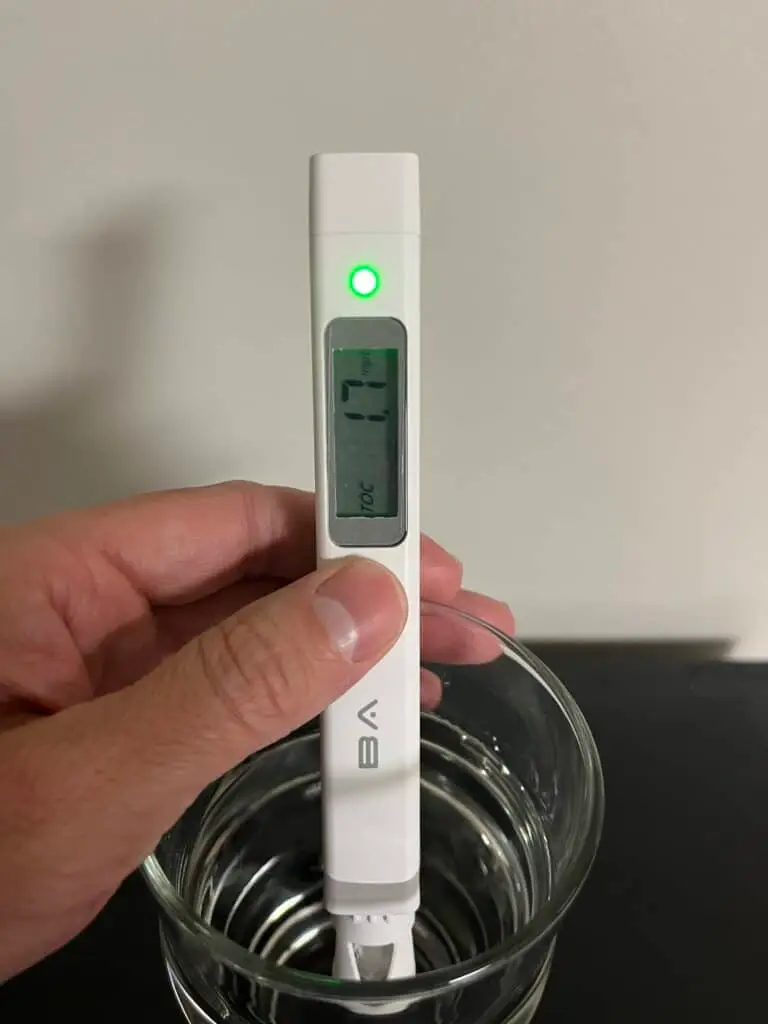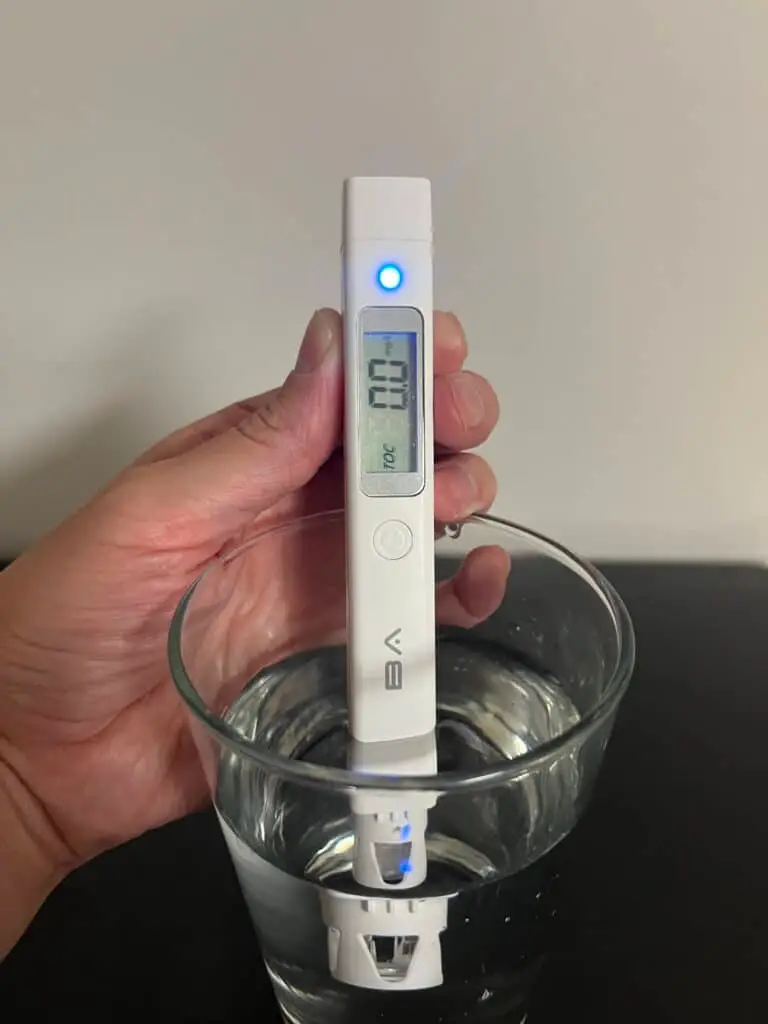Water Testing Guide
- by Ryan Moreau / updated: April 23rd, 2024
The best way to determine your water quality is to test it directly out of your tap. The pathway that water takes to get to your faucet is unique whether you are on city water or use a private well. On its journey, water picks up little bits and pieces of whatever it encounters.
For city water users, several factors influence water quality at your tap. These factors include your distance from the water treatment facility, source water characteristics, daily local pollution amounts, daily precipitation amounts, pipe metallurgy, and natural fluctuations in chemical treatment at the public water system.
If not properly treated, private wells risk contamination from local geology, agricultural and industrial runoff, and bacteria growth.
As a result of these ever-changing variables, the concentration of substances and contaminants in your water is never the same each day.
In this guide, we will walk you through several testing methods, from DIY to full-blown lab analysis of your water, so that you can accurately determine your overall water quality. When thinking about the best way to organize this guide, we thought it best to organize it by contaminant category. If you are worried about a specific type of contaminant, skip ahead to the specific section to review ways to test!

In This Guide
TapTool Water Quality Report
Before you get started, it is essential to understand your source water quality and the general characteristics of your water. You can find this information using our TapTool application to generate your local water quality report.
This report will show water contaminants and pollution data gathered from the USGS and EPA for your public water system or well. It is important to know this information even if your city water plant has methods to reduce contaminant levels. Environmental factors and human error cause significant variations in these contaminants over time.
Since water tests can be expensive, TapTool can help you narrow down contaminants of concern in your specific water source. Once you know what contaminants you can expect in your water, let’s discuss how to test them yourself.
Microbiology Testing
Water contaminated with microorganisms can pose serious health risks. If you have city water, microbiological contamination is generally not a concern, as disinfectants are used to treat the water. City water plants sometimes issue boiler orders if something happens that results in microbiological contamination. Generally, this would mean a pipe break or flooding contaminated the city water. You may consider getting a UV filter to protect against the increased risk of biological contamination if your city water plant issues frequent boil orders.
Improper application of disinfectant and your physical distance from the treatment plant can also be a reason for microbiological contamination.
Private well owners are at a higher risk of microbiological contamination and should test their water once/a year minimum. Several factors can contribute to the biological contamination of a well, such as poor construction, animal waste, agricultural and industrial runoff, natural sources, and inadequate treatment. Certain contaminants in drinking water can also provide a food source for biological activity to grow.
Testing for biological growth at home can be done both directly and indirectly. If you suspect an immediate risk of microbiological contamination, send your water to a certified lab for analysis.
Testing Disinfectant Levels at Home
You can test for the potential of biological contamination indirectly by measuring the disinfectant levels in your drinking water. If you are on city water or using a disinfectant regularly on your well, this applies to you. A cheap and reliable chlorine test can be used to detect low-range chlorine. The test results for your disinfectant should show levels within the range of 0.4 – 4.0 ppm of total chlorine. If you have 0.1-1.5 ppm of free chlorine in addition, the chances for biological contamination are low.
Lamotte makes total and free chlorine test strips that are detectable at much lower ranges than other products. These strips can effectively determine if you have adequate disinfectant levels to prevent bacteria growth. Chlorine testing should be done before any household filtration to determine levels accurately. Keep in mind, even if the chlorine levels are lower than the ranges below, this does not necessarily mean you have biological contamination, but have a higher potential for biological contamination to occur.
Testing Bacteria Levels at Home
You can purchase an at-home kit for total-coliform bacteria if you want to test bacteria directly. The coliform bacteria test indicates the overall microbial quality of drinking water. This type of bacteria is typically not harmful, but their presence can indicate the possible presence of other pathogenic microorganisms. For at-home bacteria testing, the Safe Home brand is a great option. This DIY kit tests for 50 different species of coliform bacteria.
Microbiological Lab Analysis
Now let’s say that you have been testing chlorine and the levels are consistently low, or you had a positive test for coliform bacteria. At this point, it would be a good idea to send a sample to a certified lab to confirm your results and determine what specific biological contamination you have in your water. Well water users should do this at a minimum annually. SimpleLab is an excellent resource for certified lab tests. Check out SimpleLabs Total Microbiology Water Test to test for more specific biological species.
Further treatment or filtration should be considered if you find biological contamination in your water. If you have a private well, you can choose to chlorinate it. UV filtration is also a good option for anyone worried about biological contamination of their drinking water.
Disinfectants and Disenfectant By Product Testing
We covered disinfectant testing in the previous section, as it is an essential parameter in understanding microbiological contamination. The Lamotte Total and Free chlorine testing strips will give you a good idea of how well your public water system maintains its disinfectant levels.
Some utilities use chloramine as a disinfectant in their water. You can get an approximate chloramine level by subtracting free chlorine from total chlorine. Water Systems that use chloramine as a disinfectant are likely to have lower concentrations of disinfection byproducts because chloramine is more stable.
You can check TapTool to view your water system’s average DBP levels during the EPA’s last 6-year review between 2006-2011. Higher DBP levels indicate that your water and distribution system have more Total Organic Carbon (TOC). To test for total organic carbon, check out the organic testing section of this guide.
Consider sending the samples into SimpleLab for VOC testing for a more accurate laboratory assessment of disinfection byproducts in your drinking water.
Inorganic Chemical Testing
Inorganics in drinking water can be classified into two main types: minerals and contaminants. The inorganic minerals in your drinking water are not harmful for consumption and are not regulated by the EPA. However, these minerals, such as hardness-related minerals, can form deposits on your plumbing and appliances, reducing their efficiency and life. The mineral concentration in your water is naturally occurring and depends on your location and water source.
Inorganic contaminants are another form of inorganic in your water that you should be aware of. These contaminants are both naturally occurring and pollution-related. The EPA regulates these contaminants, including heavy metals, nitrate/nitrite, fluoride, and several other substances.
This section will highlight how to measure the inorganic chemicals in your water. We will also help you determine if your water is corrosive or deposit-forming based on mineral content. For baseline corrosion and deposit data for your water, refer to TapTool.
Total Inorganic Concentration
A simple TDS meter works well to measure the overall concentration of inorganics in your water. The EPA does not provide a regulatory limit for TDS in drinking water but provides a secondary drinking water recommendation of 500 ppm. If your TDS levels are close to 500 ppm consider sending a sample to SimpleLab to determine what this TDS is made up of. Please note, the TDS level is not a direct measurement of water quality. Additional testing is always necessary to determine the overall makeup of the TDS in your water. The Essential City Water Test is the best test for inorganic testing at SimpleLab.
Corrosivity and Hardness Deposition Potential
Measuring your water’s tendency to form deposits or corrode is a prerequisite to understanding contaminants that are a byproduct of these mechanisms. Many heavy metals found in drinking water are the result of water that is corrosive. We cover more on heavy metal testing in the next section.
The most straightforward method to measure the corrosivity of your water is to measure pH. In general, if your water is below a 7, then your water is considered corrosive. However, measuring just pH does not show a complete picture of your water. The corrosivity and deposit formation potential depends on pH, Calcium Hardness, Total Dissolved Solids, and Alkalinity. These four parameters can be used simultaneously to determine the Langliers Saturation Index (LSI) and the Ryznars index to determine your water’s overall corrosivity or deposit potential. To measure these values, you can purchase a simple LSI test kit and a dual pH/TDS probe. Once you measure these values, use the LSI calculator that follows to determine your water’s characteristics.
If the results of your water show high to very high deposit potential, you should consider installing a softener.
Signs that you may need a softener include:
- Water spots and stains on shower and dishes
- Dry hair and skin
- Difficulty getting laundry clean
- Poor hot water flow and visible signs of hardness scale on household plumbing and appliances
Ignoring these concerns can lead to premature failure of your water heating, plumbing, and other household appliances.
If your water shows moderate to very high corrosion potential, you should consider installing an acid neutralizer.
Signs that you might need an acid neutralizer include:
- Discoloration and staining of sinks and bathroom fixtures from corrosion of household plumbing
- Iron corrosion will show up as a reddish brown or yellow stains and a metallic taste
- Copper corrosion shows stains that are blue-green and also gives water a metallic taste
- Lead corrosion has no visible signs; if your water is corrosive, you should inspect your home plumbing and call your local water utility to see if you have any lead service lines providing water. Homes built before 1991 are more likely to have lead.
If your water is corrosive and your distribution system contains lead, you should consider installing a point-of-use activated carbon or reverse osmosis system to remove lead and other heavy metals.
Langliers Saturation Index
Deposit and Corrosion Calculator
Heavy Metals
The main risk of corrosive water is the health risks associated with dissolved metals in water, such as lead, copper, and iron. Other heavy metals found in water, such as arsenic, mercury, cadmium, and chromium, are naturally occurring elements from your source water. Once these contaminants enter the water supply, they can accumulate in the body over time, leading to various health problems.
Lead, Copper, and Iron
If your water is highly corrosive, sometimes it can show up in obvious ways. Copper and iron corrosion can leave some obvious signs, such as discoloration of bathroom fixtures and sinks. If your water is corrosive, you should take extra precautions to protect yourself and your family from lead contamination.
Check your TapTool water quality report to see the average lead levels in your distribution system and the last date they were reported. You can also call your local water utility to check if any lead distribution lines provide water to your home, and inspect your home plumbing for lead. Simple testing strips are good for detecting the presence of these metals. If detected, these strips can be used to determine if they are coming from your distribution system or your house by testing where the water comes into your house and at your faucets. For more accurate testing of these metals, sending your samples to a professional lab is best.
Since these metals are primarily corrosion related, it’s best to sample your water as you would drink it. Testing the water after flushing it for several seconds is also good data as it can indicate that the contamination is coming from your well or distribution system, not your plumbing. If you send samples to SimpleLab, they will have detailed procedures for drawing the best sample for testing purposes.
Naturally Occurring Heavy Metals
Heavy metals, arsenic, mercury, cadmium, and chromium occur naturally in the earth’s crust. These metals’ presence highly depends on your location and whether you are drawing from a groundwater or surface water source. If you find these metals in your source water, it’s a great idea to test them at your tap to see the concentration. Arsenic is common and often exceeds the EPA’s goal (MCLG) of 0 ppm in many public water systems and wells. To test for these heavy metals, you will have to send your samples to a certified lab, as there is not a good at-home method.
Radionuclide Testing
Testing for radionuclides in water is an important aspect of water testing, as these substances can pose serious health risks if present in high concentrations. Radionuclides are unstable atoms that emit radiation, and they can be found naturally in rocks and soil or released into the environment through industrial or nuclear activities.
Common radionuclides found in water are radium, uranium, and gross alpha. These are naturally occurring elements that can leach into groundwater from rock formations.
The testing process for radionuclides in water typically involves collecting a sample of the water and sending it to a laboratory for radiation analysis. The laboratory will use specialized equipment to detect the presence and concentration of radionuclides in the water sample.
Organic Chemical Testing
Organic compounds can be naturally occurring or man-made, including chemicals such as pesticides, herbicides, industrial solvents, and pharmaceuticals. The testing for organics in drinking water is typically carried out by certified laboratories that follow standardized protocols and use validated methods. The United States Environmental Protection Agency (EPA) regulates the testing and monitoring of drinking water for organic compounds and sets standards for the maximum allowable levels of organic compounds in drinking water.
Total Organic Carbon Testing
The best method for testing organic contamination of your drinking water is to test for Total Organic Carbon (TOC). The Environmental Protection Agency (EPA) has set a maximum contaminant level (MCL) of 2 mg/L for TOC in drinking water in the United States. TOC levels in drinking water can vary depending on several factors, including the source of the water, the treatment processes used, and the distribution system. High TOC levels in drinking water can lead to various issues, including taste and odor problems, disinfection byproduct formation, and microbial growth.
Until recently, TOC levels could only be measured with expensive instrumentation in a certified laboratory. The Envig BA Digital Water Quality Tester is an inexpensive method for getting approximate TOC readings at home. We were skeptical of this claim at first but put it to the test against a home carbon filtration setup and found it could accurately test the TOC levels. We tested the meter against DI water, local city water, and city water filtered through activated carbon. The results were as expected, with the DI water and the carbon filter water reading 0 ppm of TOC. The city water sample showed 1.7 ppm of TOC before carbon filtration.
If your at-home TOC test is consistently greater than 2 ppm, consider sending a water sample for off-site analysis to confirm the TOC level and determine the specific organics that are in your water. Point of use Activated Carbon filtration systems are effective at removing almost all TOC levels and result in safer, better-tasting water.
City Water Testing
If you don’t want to mess with at-home testing but still want to know what is in your water, you can send your water samples to a certified lab and have detailed testing done. For city water, SimpleLab offers three options. Check out each option to find out what best fits your needs.
1. Essential City Water Option – Cheapest option that tests for 47 total contaminants, including fertilizers, heavy metals, and inorganics.
2. Advanced City Water Option – Middle range option that tests for 109 total contaminants, including Disinfection By-products, Fertilizers, Heavy Metals, inorganics, and a wide range of organic contaminants.
3. Extended City Water Option – Most expensive option that tests for 118 total contaminants, including Disinfection By-products, Fertilizers, Heavy Metals, inorganics, organic contaminants, and radionuclides.
Well Water Test Kit
If you own a private well, frequent testing is imperative to ensure your water is safe and contaminant free. The EPA recommends testing your private well annually for total coliform bacteria, nitrates, total dissolved solids, and pH levels. If you suspect the presence of other contaminants, you should test for those also.
For well water test kits, SimpleLab offers 3 different options.
1. Essential Well Water Option – Cheapest option that tests for 52 total contaminants including bacteria, fertilizers, heavy metals, Hydrogen sulfide, and inorganics.
2. Advanced Well Water Test – Middle option that tests for 112 total contaminants including bacteria, disinfection byproducts, fertilizers, heavy metals, inorganics, hydrogen sulfide, and an extensive list of organics.
3. Extended Well Water Test – Most Expensive Option that tests for 182 total contaminants including bacteria, disinfection byproducts, fertilizer, heavy metals, herbicides, inorganics, organics, pesticides, radeonuclides, hydrogen sulfide, and tannins.
If you wondering where to start, TapTool is an excellent option to help you narrow down areas of concern, combining local source water data, city water data, and pollution data to provide a starting point.








